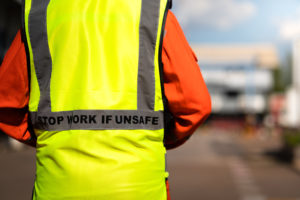6-minute read
New rules requiring health care employers to provide protective equipment like masks and to screen and triage patients for the risk of Covid-19.
New unannounced weekend inspections at certain construction jobsites in an effort to curb fall and trench accidents.
A renewed effort to toughen hazardous materials handling standards.
The Occupational Safety and Health Administration sure has been busy lately. Not that we didn’t expect as much.

Long before the new administration moved into the White House in January, worker advocates and former labor officials predicted a push to revamp and strengthen the federal agency charged with enforcing workplace safety.
The message to employers amid all this? Revisit your workplace safety policies now, if you haven’t already.
Construction Site Crackdown
Construction employers should be particularly concerned because OSHA typically steps up its focus on construction work sites in the warmer months.
OSHA is now already conducting unannounced weekend inspections at Colorado jobsites.
The agency announced its “Weekend Work” initiative in a press release, where it pointed to six worker fatalities from falls, as well as three deaths associated with excavation collapses and trenching incidents in Colorado over the last two years.
The initiative is specifically targeting a period – the weekend -- when contractors may let their guard down.
Whether OSHA will expand the crackdown to other states is unknown, but construction companies should expect it will.
Making Noise
Elsewhere, OSHA recently kicked up enforcement of its occupational noise exposure standard in Midwest manufacturing facilities.
Plants in Illinois, Indiana, Michigan, Minnesota, Ohio, and Wisconsin all should expect to see OSHA inspectors more often. (Speaking of inspectors, the administration is expected to potentially double the number of OSHA inspectors from the current 761, which is down almost 25% from a decade ago.)
“Earning a living should not come at the expense of hearing loss,” OSHA Acting Regional Administrator William Donovan said in a statement. “Hearing conservation programs are designed to prevent workplace hearing loss, protect remaining hearing, and provide employers and workers with the knowledge and equipment to control and reduce exposure to noise.”
Handling Hazards
This fall, OSHA plans to hold hearings on proposed changes to what’s known as the Hazard Communication Standard.
OSHA says it wants to align the rules with international codes for management of hazardous materials, but in doing so the agency may end up classifying some materials as hazardous that, in the past, had not been.
Perhaps ironically, some stakeholders have expressed concerns over the impact of the changes on worker safety. In particular, the California Division of Industrial Relations Division of Occupational Safety and Health – aka Cal/OSHA – and work-safety groups have expressed a fear the proposed amendments will limit protections for workers.
How? Because, according to Cal/OSHA, the proposal would leave it solely to producers to classify their products’ hazards, rather than environmental regulators.
Industry groups, on the other hand, are concerned the proposed changes would place an impossible regulatory burden on manufacturers and importers to compile substantial data on hazards posed by their products.
Assuming the new rules go into effect – a very real possibility, indeed – employers would need to review their hazardous material handling policies, ensure proper product classification, and update their written programs and training materials.
Employers also will have to train affected managers, supervisors and employees.
On the Healthcare Front
OSHA, which rarely makes everyone happy, elicited plenty of groans in early June when it issued its latest Covid-19 rules, which protect healthcare workers but do not extend to other sectors such as manufacturing, grocery or high-volume retail.
The new rules require healthcare facilities with 10 or more employees to conduct a hazard assessment and create a plan in writing. They spell out when to require masking, distancing and physical barriers.
The standard also requires covered employers to provide workers with paid time off to get vaccinated and to recover from any side effects.
Employers were given 14 days to comply with most of the provisions. Perhaps offering some relief, OSHA said it would try to avoid citing employers who miss a compliance deadline, as long as they were making a good faith effort to comply.
That, in fact, isn’t unusual for how OSHA deals with noncompliance. Still, we suggest that a renewed focus on safety compliance would be in your best interest. OSHA, after all, is only likely to get more serious about its mission over the next few years.
The Mahoney Group, based in Mesa, Ariz., is one of the largest independent insurance and employee benefits brokerages in the nation. Contact us online or call 480-730-4920.
This article is not intended to be exhaustive nor should any discussion or opinions be construed as legal advice. Readers should contact legal counsel or an insurance professional for appropriate advice.
